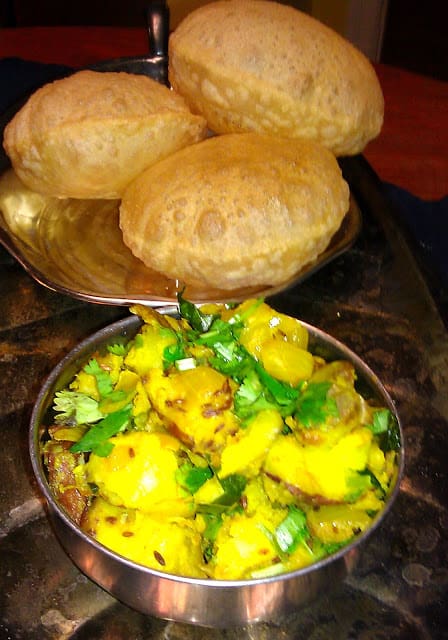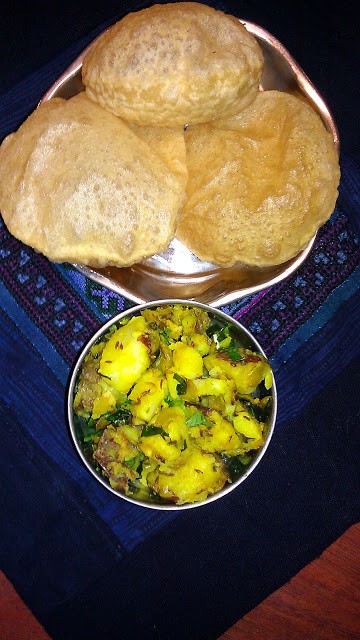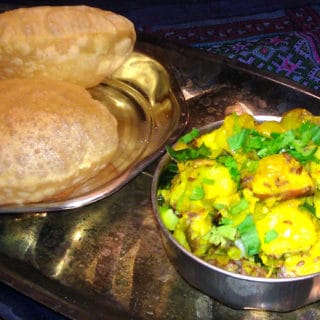Poori Bhaji (puri bhaji) is about as delicious as Indian food gets: and by that I mean pick-your-fingernails-with-your-teeth-to-devour-every-last-crumb delicious. This is pure comfort food: the kind that gets made at every festive occasion in an Indian kitchen, no matter where in the world that kitchen is. The kind that kids carry to picnic lunches, the oil from the poori making transparent blotches on the newspaper it’s wrapped in. And the kind I feel like eating when I will settle for nothing short of pure perfection at the dinner table. It wouldn’t be stretching the truth to say that there are perhaps as many versions of Poori Bhaji as there are Indian cooks. Although the poori, or the puffy, deep-fried bread, remains more or less the same except the addition of spices in some cases, the bhaji, or the vegetable component, varies drastically. It’s almost always made with potatoes but everyone puts their own delicious spin on the versatile spud: gravied, dry, spicy, mild, tangy with lemon, or alive with the spicy pungency of curry leaves. When I lived in Bombay, one of the most popular places to go to if you were craving a plate of Poori Bhaji was Pancham Puriwala, a famously crowded and unpretentious dhaba/restaurant that sits not far from the grand Victoria Terminus railway station. According to Busybee, the now-dead but still-entertaining chronicler of Bombay’s eateries, it predates the British-era VT building and was started by an immigrant from Agra in north India who singlehandedly cooked and sold his Poori Bhaji more than 150 years ago. The Pancham I was familiar with had grown into a much bigger establishment, but it still sold nothing but poori bhaji. Hundreds of people who worked around the busy Fort area would pour into the restaurant for lunch. It was – if I remember correctly– a salt-of-the-earth establishment with hardy wooden tables flanked by long benches. There’d be some pickles at the center of the table to spice up the meal. The place was intensely noisy and crowded and hot and humid – a microcosm of the city itself– but you could be sure to get your order fast from one of the super-efficient waiters for a truly nominal price. I loved the atmosphere, but I never really acquired the taste and fascination for Pancham Puriwala that some of my friends had– perhaps because I had tasted better in my mom’s kitchen. Check to get new recipe updates by email.
We Maharashtrians tend to make a dryer version of the potato bhaji– at my parents’ house, the Bhaji was always an ultra-simple, yellow-hued delicacy specked with the green fire of fresh chillies, the lemony bite of coriander, and the smokiness of cumin seeds. It was a dish you couldn’t help but love. I’ve posted a detailed tutorial on how to make poori before, so I am just going to send you to that link. My poori bhaji is exactly like the one my family made, only for the bhaji, instead of adding the curry leaves whole and then discarding them as some people do, I chop them into small bits and saute them along with the onions because I love how they complement the potatoes in each bite. And I also mash my potatoes a little because that way they are perfect to scoop up with the pooris. The potatoes also get a little bit crusty that way. Here it is, a recipe that can make any day– however humdrum– just a little more special. Enjoy!
Try these recipes next:
Pav Bhaji Tawa Pulao Jeera Aloo (Stir-fried Potatoes with Cumin) Crispy Baked Potato Vadas (No added fat) Easy Vegan Grilled Naan
Recipe card
Love this puri bhaji recipe? Check out more Marathi recipes on Holy Cow Vegan!



